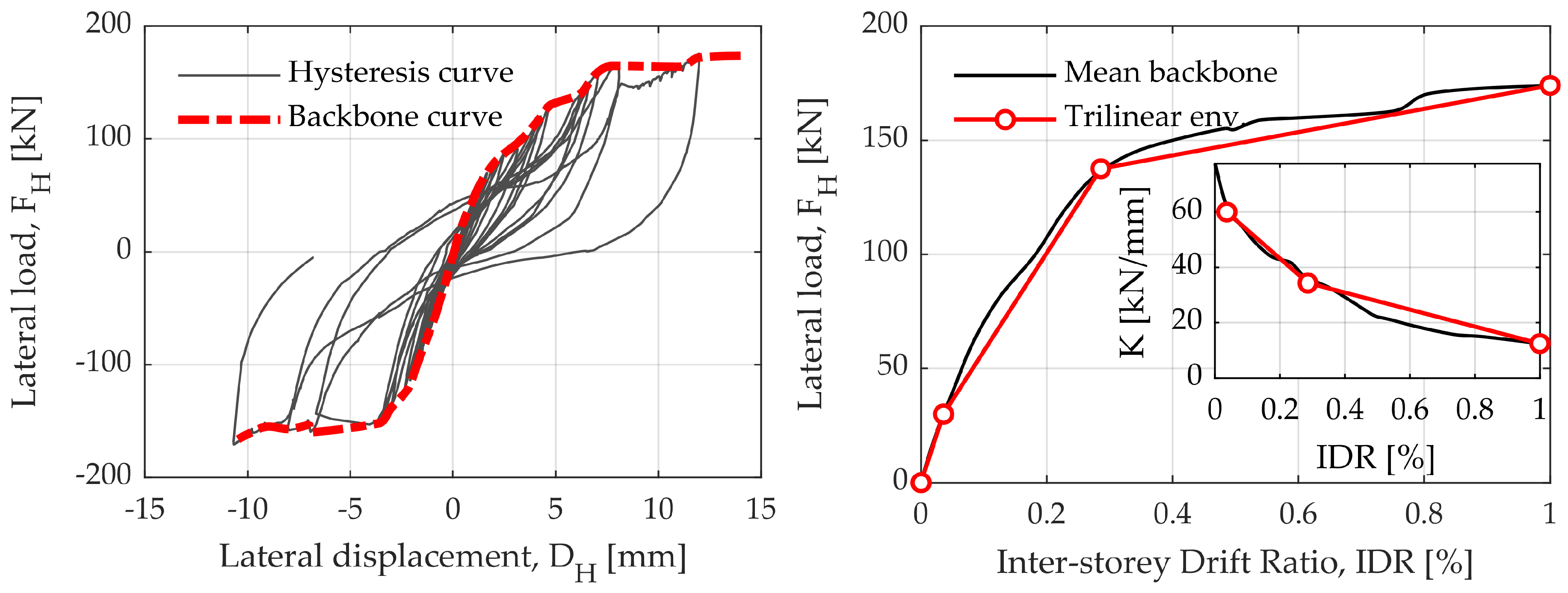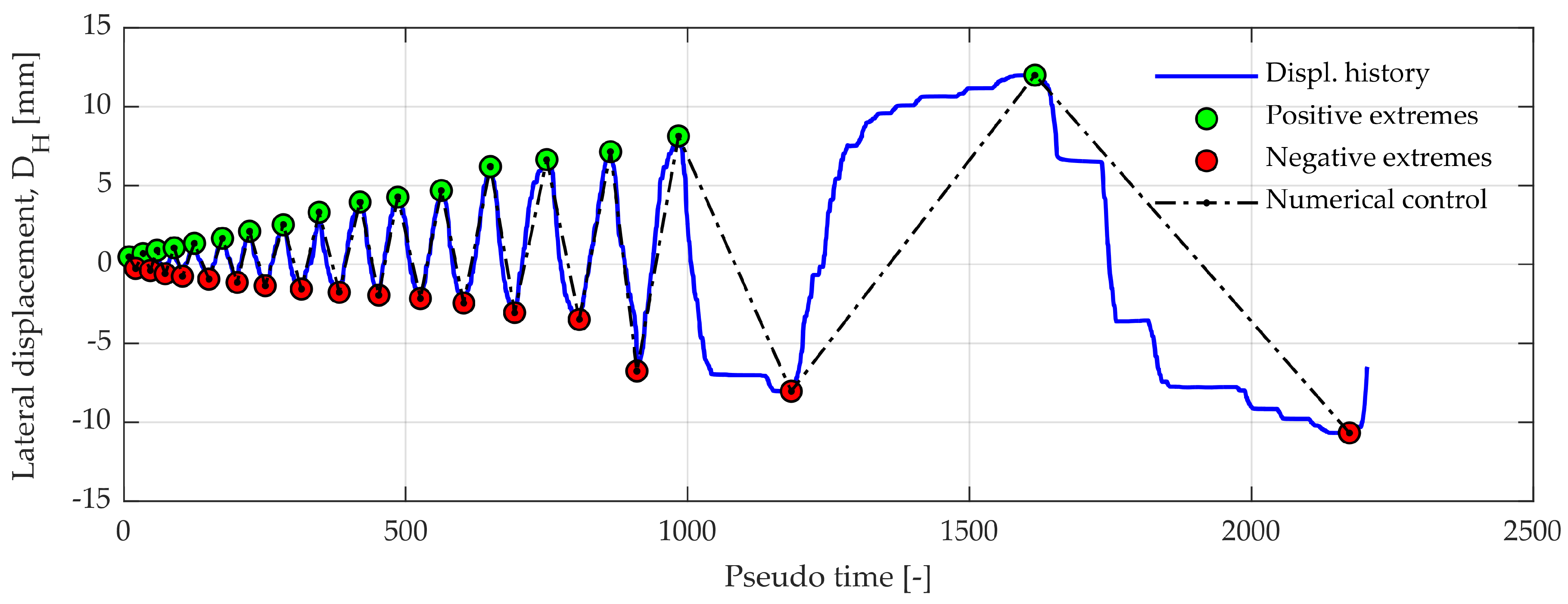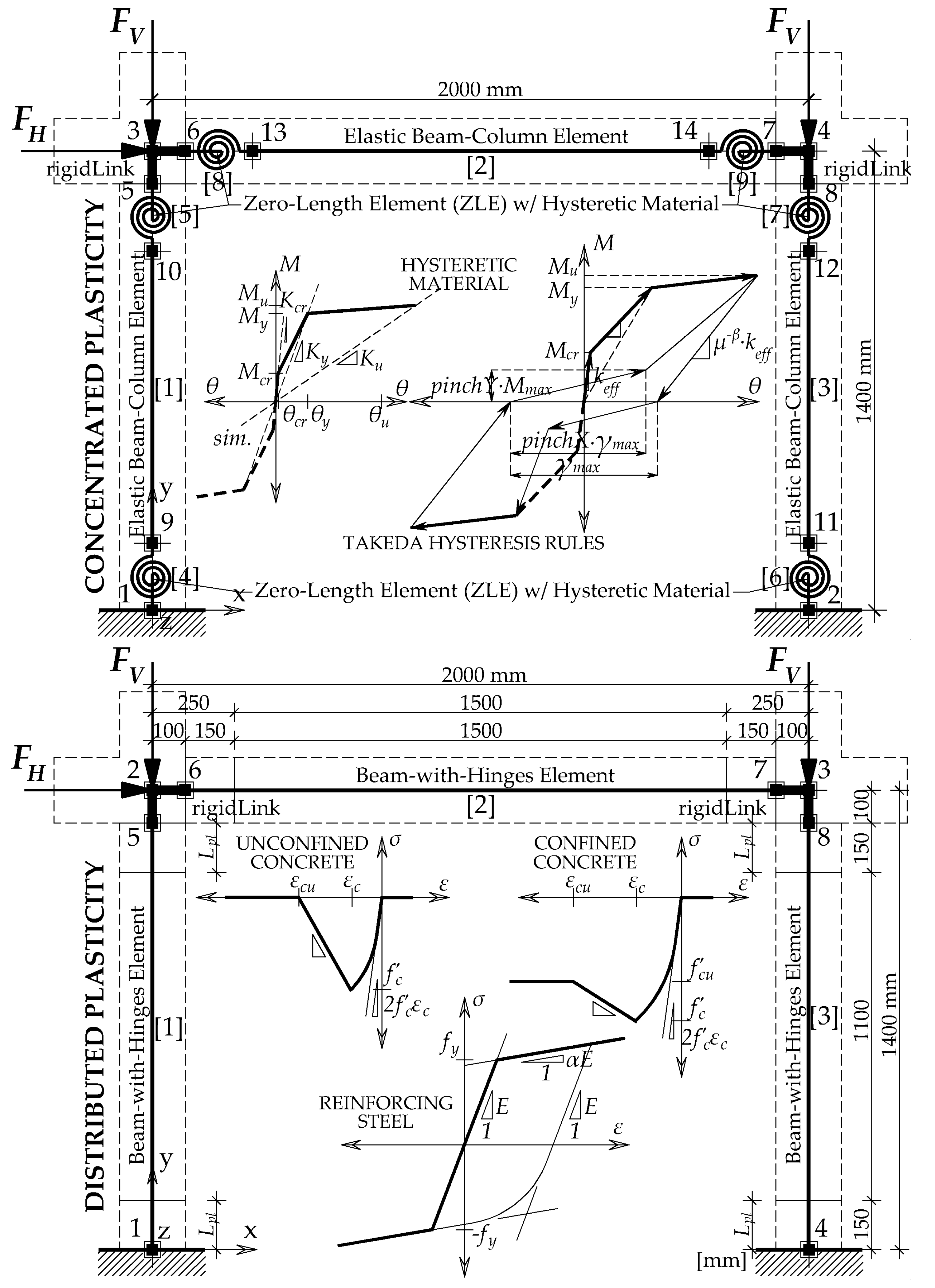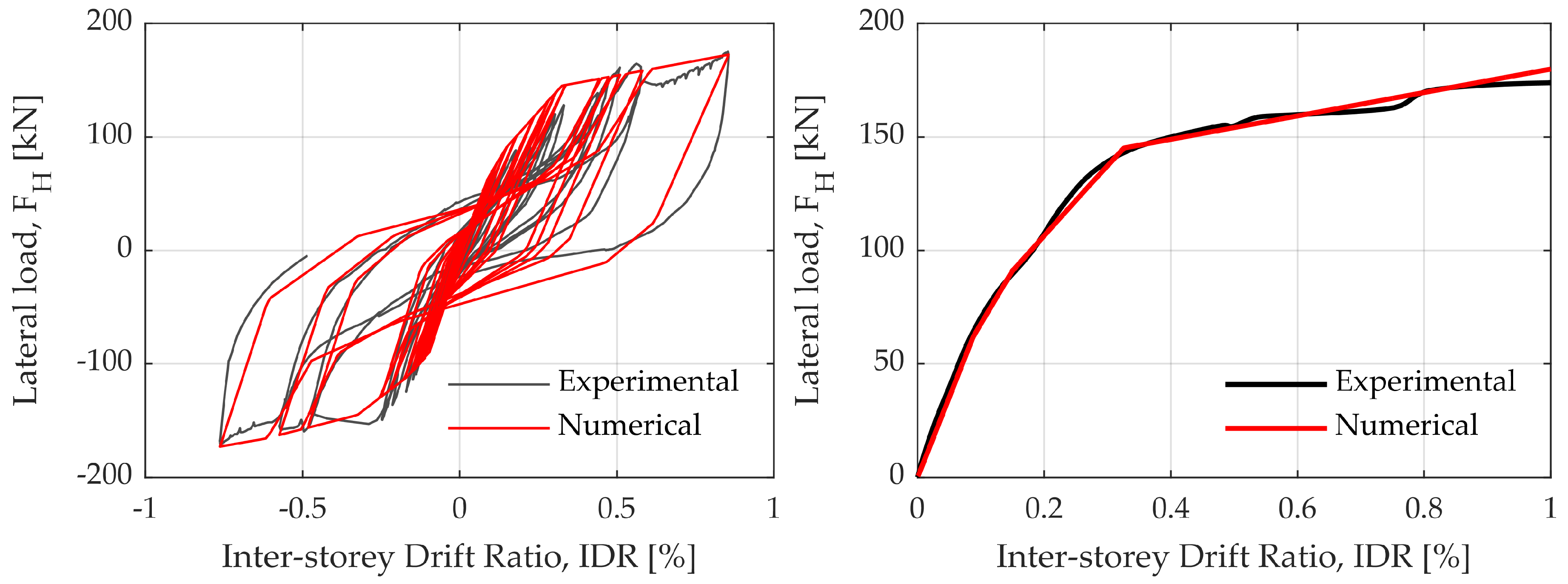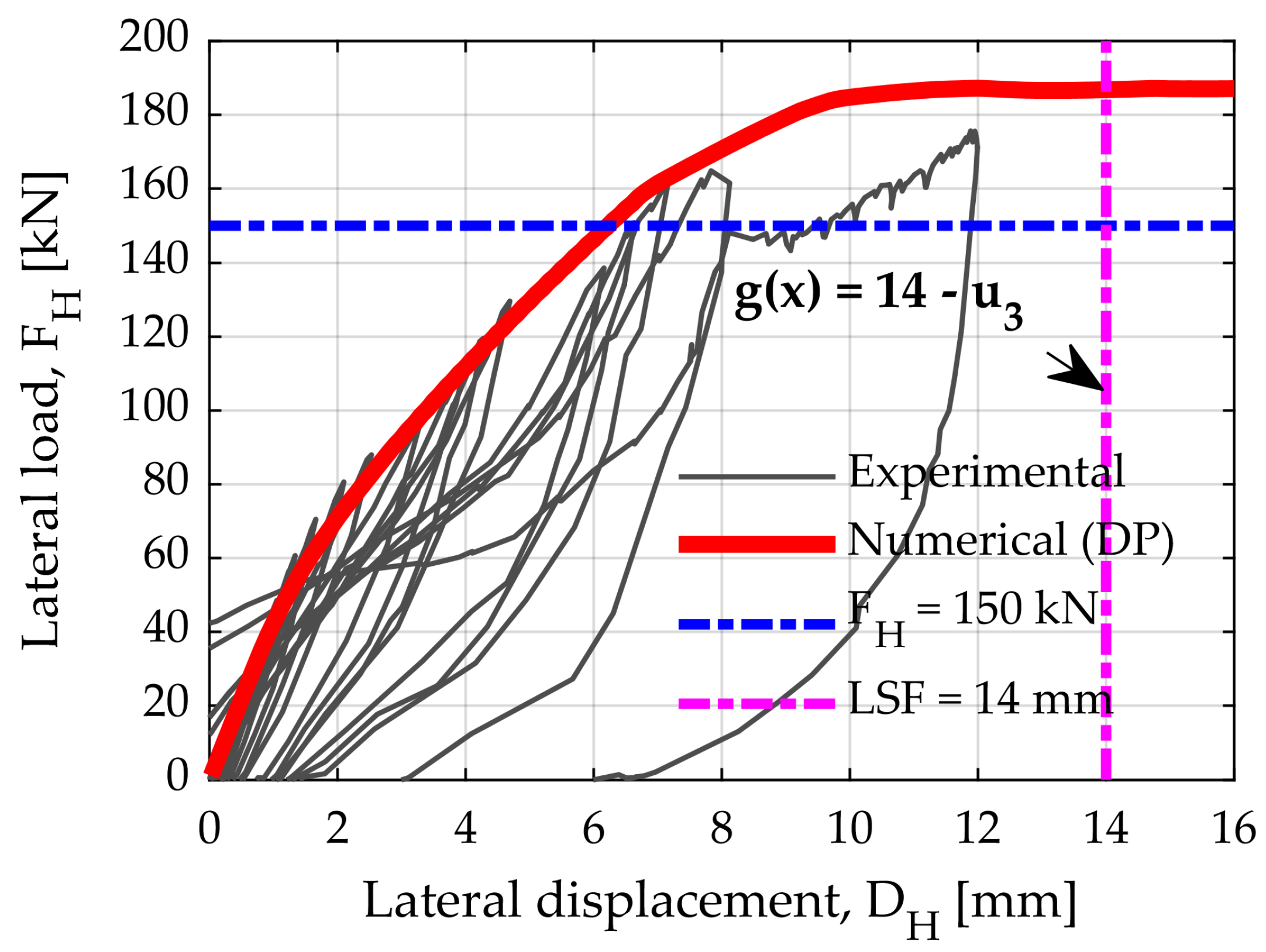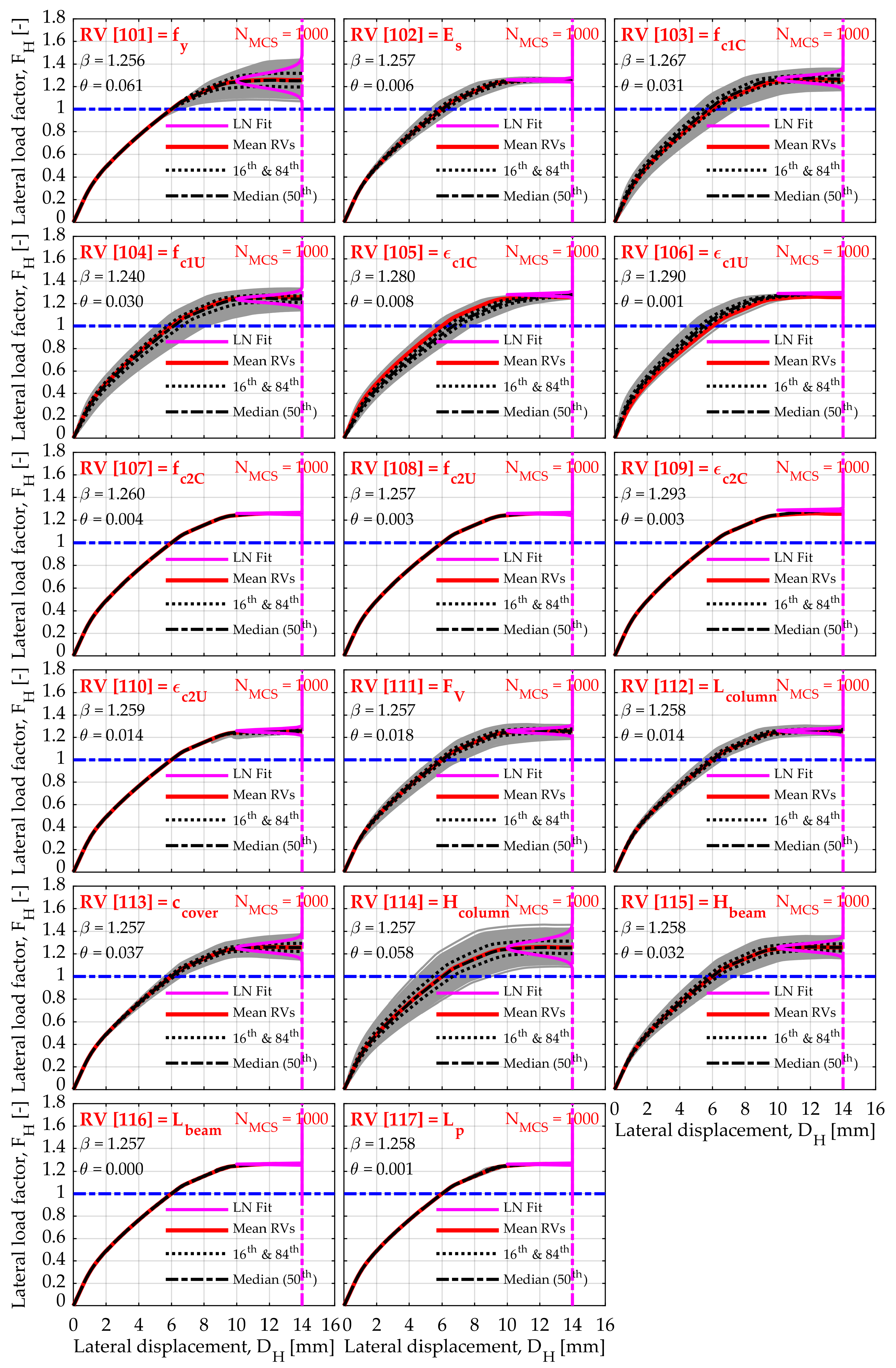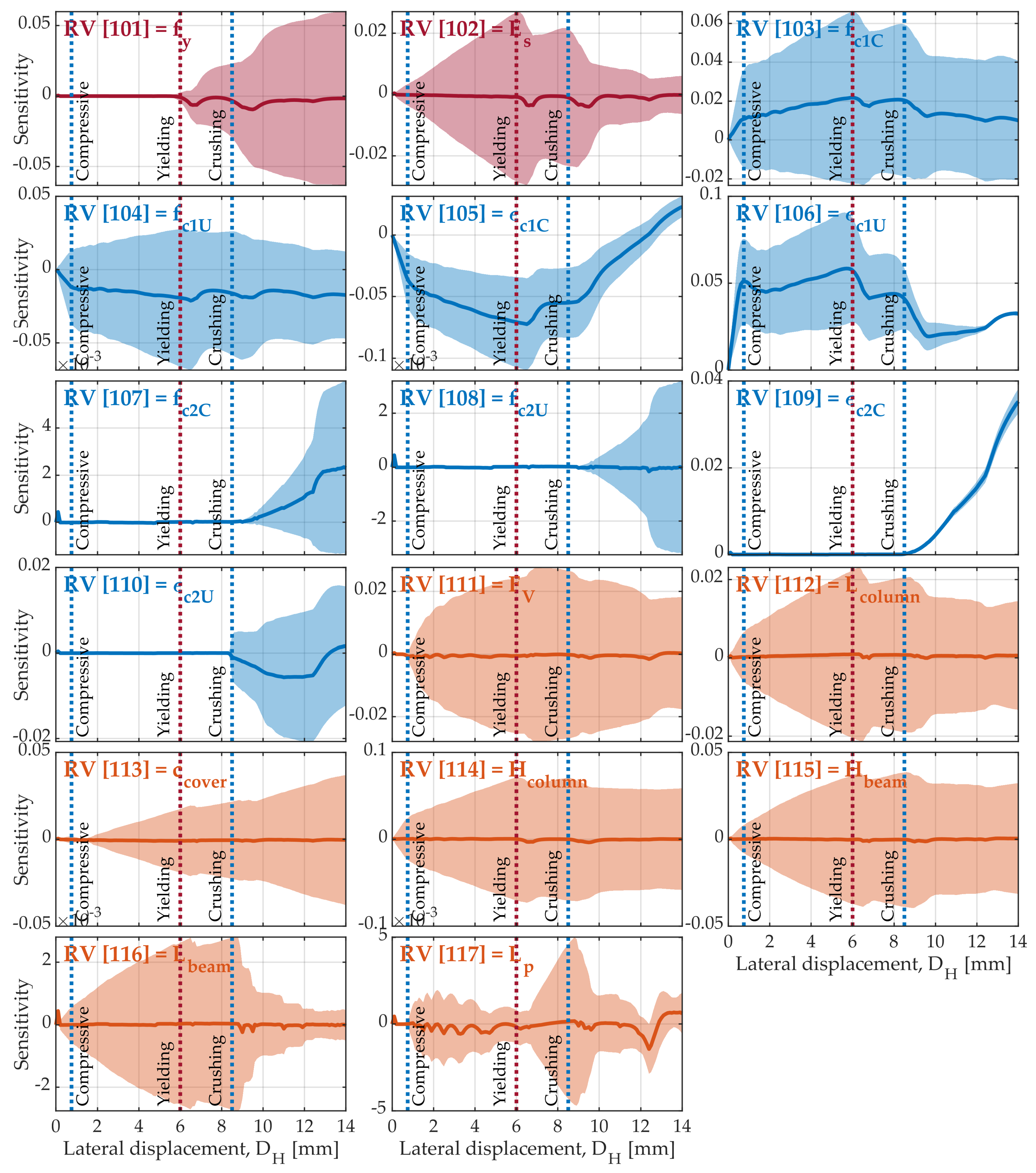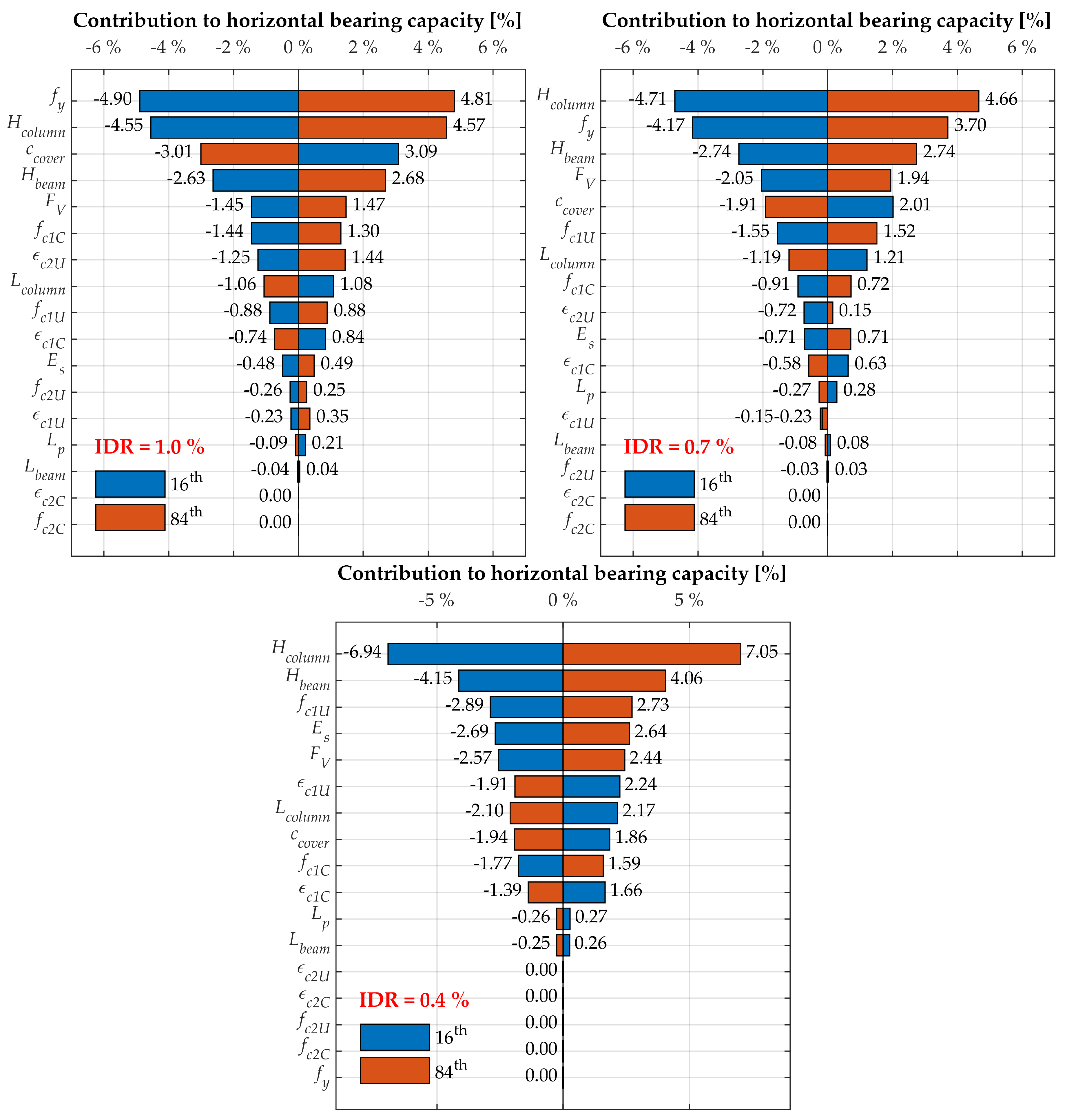5.1. MVFOSM, FORM, and SORM Analyses
For different types of reliability analysis, it is interesting to compare the probability of exceeding the LSF.
Table 2 and
Table 3 show the rank list of RVs and their ranked importance vectors, obtained from the FORM analysis, according to the
and
vectors, respectively, by considering and not considering the correlation between the defined RVs for the given LSF
.
Table 2 and
Table 3 show the difference in the order of importance vectors with and without a defined correlation. The values of
show the values of individual parameters for the same horizontal load of 150 kN reaching exactly the Design Point response, which is defined by the LSF and in this case was 14 mm or 1.0% of IDR. The pushover curves with the mean values of all parameters, and the design point values, are shown below for all MCS. The values of
can also optimise the system in such a way that the iterative procedure monitors the mean value difference
regarding design point values
, thereby rationalising certain cross section dimensions, frame geometry or mechanical properties of the material (reliability-based design optimisation). It is important to emphasise that the list of parameters of RV, ranked by the importance vectors, is certainly sensitive to specific implicit LSF, i.e., the order of importance vectors does not apply to any other pre-defined LSF, which is visible from the Tornado Diagram Analysis (TDA). In addition, most design solutions will remain in the linear range of behaviour throughout their lifetime, where the optimisation of such linear systems would be even simpler, and there would be no significant between individual LSFs regarding the importance of some RVs if the structure behaves linearly.
Correlation affects not only the parameters to which it relates, but also all the parameters with which they interact within a numerical model. At the cross-sectional level, maximum compressive strength of the confined and unconfined concrete,
and
, the total height of the beam and columns cross section,
and
, the depth of the concrete cover for both columns and beams affecting the effective height of the cross sections,
and yield strength of reinforcing steel,
were the most sensitive parameters for the main LSF, considering the correlation between the parameters. Since the characteristics of reinforcing steel affect the behaviour of the confined concrete, the parameter
became the most important parameter for the LSF
. It is interesting that the first 8 of 17 parameters (
Table 2 and
Table 3) were equally important by considering and ignoring the parametric correlation, except parameter
. The concrete crushing strengths (
and
) and deformations at the maximum concrete strengths (
and
) and the plastic hinge length (
) proved to be the least significant parameters for the main LSF. The focus of the parameters for the main LSF should be in
Table 2, since most RVs were not statistically independent (
).
The FORM analysis was completed with a total of 29 iterations using the
HLRF procedure, evaluating a total of 60 approximations of
g-functions. SORM analysis was also performed in two ways: by adopting the First Principal Curvature, SORM-FP, and applying Curvature Fitting by combining 10 curvatures for better approximation of the SORM-CF reliability index. The difference in the reliability index of
and
was only 0.127%, thus the probability of the limit state exceeds
% or
%. Furthermore, a comparison of the two additional LSF was added (10 mm and 6 mm of horizontal displacements) to compare the trend of declining reliability with respect to the reduction of the LSF. In
Table 4, the reliability indexes for MVFOSM, FORM, SORM-FP and SORM-CF were compared for the 14 mm, 10 mm and 6 mm horizontal displacements as LSF. During these analyses, it was concluded that the ranks of important parameters based on
and
vectors were not the same for all three LSF, which is common for nonlinear systems since not all parameters affect equally the predominantly linear and nonlinear part of the model response. Based on these conclusions, a tornado diagram is constructed [
32,
41,
42,
43], by applying displacement control as deterministic sensitivity.
It is worth mentioning that the values of the reliability index,
in
Table 4 for FORM and SORM analysis are less than the guidelines for Eurocode 0 for residential and office buildings. According to Eurocode 0 [
44], recommended minimum value for the reliability index,
(ultimate limit states) for Consequences Class 2 (CC2), that is Reliability Class 2 (RC2) and 50 years reference period is
or
.
5.2. Monte Carlo Simulations
The results of the Monte Carlo analysis (conventional brute-force Monte Carlo) for the 10,000 simulation are presented below, carrying out a nonlinear analysis with Load Control (LC) of 150 kN in 40 steps per 5 kN (
Figure 7).
Figure 7 shows values of log-normal (LN) mean (
) and standard deviations (
), and the diagrams are normalised based on horizontal force. The difference between the red and blue pushover curves should be noted. The red pushover curve was derived using the arithmetic mean values of all RV parameters. The blue pushover curve was based on the RV parameters obtained by FORM analysis (
values based on the
Design Point) regarding the default LSF
. As a by-product, FORM analysis provided importance measures (
and
vectors in
Table 2 and
Table 3) to rank the uncertain parameters according to their relative influence on the structural reliability index,
. Based on these importance vectors, FORM optimised the values of all RVs (
values), in which combination was exactly reached the Design Point or Most Probable Point (MPP). Thus, the difference between red and blue pushover curves is necessary and presents a useful product of the FORM analysis.
Given the complexity of the system, in
Table 5 we can see that, for a sufficiently accurate calculation of the probability of exceeding the given LSF, 100,000 (
) simulations is recommended.
Table 5 also shows the comparative values of the exceedance probability,
, of the individual LSF, for the MCS and horizontal displacement of 14 mm, 10 mm and 6 mm, respectively, compared to the FORM analysis. It is evident that, with a relatively small number of MCS, it can be sufficiently accurate to predict the probability of exceeding the pre-defined limit state. In addition,
values for the number of MCS lower than
may vary significantly depending on the number of RV, complexity of the model and its degree of freedom.
Since
simulations can be carried out in almost 5 min for this example (and the configuration of today’s average laptop), there is no reason to sacrifice the number of simulations and the accuracy of the reliability or sensitivity analysis itself. In this and more complex cases, a more rational
Latin Hypercube Sampling (LHS) method would have to be considered, depending on the possibilities of the programming language, such as Python or MATLAB for compatibility reasons [
45,
46]. The effect of the MCS contribution to the number of simulations (
) in the significant nonlinear response domain of the numerical model is equally illustrated. For this purpose, pushover curves (load-displacement response) using MCS were computed with a displacement control (DC) incremental solution strategy (controlling displacement increment) to enable the model to converge in the negative stiffness domain (post-peak bearing capacity).
The displacement control was performed up to the 1.12% IDR, i.e., up to a 16 mm of horizontal displacement in 64 steps, making a step of 0.25 mm (
Figure 7). The most important advantage of the displacement control is that we can track the contribution of the horizontal bearing capacity in a substantially nonlinear range, which in this case had a significant effect after a horizontal displacement greater than 6 mm, or IDR > 0.43%. It is interesting to see how some RVs parameters reflected the response of the model using an MCS, with displacement control up to 16 mm of horizontal displacement. It should be noted that the mean pushover curve, after a 1.0% IDR (14 mm), showed that the horizontal bearing capacity of the model stagnated (
Figure 7). The following diagrams show the influence of individual parameter (while others were kept at their mean values) on the global nonlinear response of the numerical model. For example, in the first diagram, we can see that the effect of the yield strength of reinforcement steel (
) was only apparent after the global model yielding, which occurred at a horizontal load of
kN, based on which these diagrams were normalised (showed by lateral load factor
). All diagrams for the impact of individual parameters are displayed for
MCS. The red pushover curve is equal in all diagrams and shows the mean value of the pushover curve, with all parameters implemented with its arithmetic mean values.
Figure 8 shows 16th and 84th percentile values that were later used in the TDA.
Figure 8 shows how much a particular parameter is sensitive to the contribution of the system’s horizontal bearing capacity, thus displaying vertical statistics at the 1.0% IDR level (
mm).
Figure 8 shows a dominance of significant parameters in a more pronounced nonlinear range:
,
,
,
,
and
, respectively. As a supplement to
Figure 8,
Figure 9 is added showing the sensitivity of individual RV in the form of standard deviation relative to the horizontal displacement,
. It is interesting to see when certain parameters were activated with their contribution to the system’s bearing capacity. Notice the parameter
at a horizontal displacement of 6 mm (0.43% IDR). Almost the same trend had the crushing concrete parameters
,
,
,
. It is interesting that almost none of the parameters related to the properties of concrete had a linear median curve due to significant softening effects. The following limits are also shown in
Figure 9: the maximum reached a compressive strength limit of the unconfined concrete,
and
, the reinforcement yield strength limit,
, and the limit as the beginning of concrete crushing,
,
and
.
The tornado diagrams (
Figure 10) were also constructed by applying the displacement control (DC) pushover analysis for deterministic sensitivity, which has become commonplace in reliability analysis of the field of earthquake engineering [
31,
32,
41,
42,
43,
47,
48]. The TDA is a first-order sensitivity analysis. It comprises a set of horizontal bars, one for each input RV, whose lengths represent the variation of the EDP due to each considered input RV. The diagram is intuitive to read, and it helps the analyst identify which parameters to focus on. Each input variable is set to its median value (50th percentile), and the output is measured, establishing in this way a baseline output. One by one, each input parameter is fixed to both high and low extreme values of their probability distributions (generally corresponding to the 16th and 84th percentile, especially if the input distributions are different). The input parameters are ranked according to their absolute response difference (also called “
swing”) so that the larger
swing belongs to the variable producing the most significant uncertainty [
43]. Repeated analyses observe the difference in the model response, in this case, the horizontal bearing capacity was represented in the percentage of response difference regarding the median pushover curve.
Since the overall response of the observed model is a combination of simulations of values with normal and log-normal distributions, the overall response was treated as log-normal distributions, thus we chose 16th and 84th percentile values.
Figure 10 shows the different parameter importance for the three horizontal displacement limit states. Particularly noticeable the parameters that increase, compared to those that reduce the horizontal bearing capacity of the model (visible in
Figure 10 in two different colours). In the predominant linear range of system behaviour (0.4% IDR), the effect of significant parameters responsible for influencing the initial stiffness of the system, such as
,
,
,
,
,
,
and
is visible. Parameters of crushed confined concrete did not contribute to any of the LSFs shown. For 0.4% IDR, the parameter
did not affect the system’s bearing capacity, as expected, while for 1% IDR it was the main significant parameter affecting the system’s capacity. In the linear range, it is evident that the geometrical characteristics of the cross sections were the main contributors to the system’s bearing capacity (
and
) and the stiffness of constituent materials expressed as elastic modulus (
and
defined as
).

